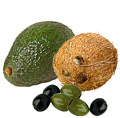Good Fat! Bad
Fat!
Hydrogenated?
We hear a lot
about good fats and bad fats, monounsaturated, polyunsaturated,
and hydrogenated. But what does it all mean?
Polyunsaturated fat is found in vegetable oil like corn,
safflower, soybean, cottonseed, and sunflower, as well as in
fish. It's called the good fat because
it helps lower LDL cholesterol, the bad cholesterol that causes
coronary artery disease (CAD) and stroke.
 Monounsaturated fat is
the other good fat, found in olives, avocados, peanuts, sesame, and
rapeseed oil (Canola). It also helps lower LDL cholesterol and
prevents CAD. Monounsaturated fat is
the other good fat, found in olives, avocados, peanuts, sesame, and
rapeseed oil (Canola). It also helps lower LDL cholesterol and
prevents CAD. 
Saturated
fat is
found predominantly in foods of animal origin, like meat, eggs,
cheese, and milk but also in coconut and palm oil. It's called
the bad fat because it raises LDL levels and contributes
to CAD, heart attacks, and stroke.
Unsaturated means it's not saturated
and refers to mono and polyunsaturated fats, so unsaturated fats
are also good fats.
Hydrogenated fats (trans fatty acids) are made by
pumping hydrogen atoms into a polyunsaturated liquid oil, usually
corn oil, to make it solid at room temperature. The result is
a soft margarine that's easy to spread. Hydrogenated fats consist
of a combination of polyunsaturated, monounsaturated, and saturated
fats. Whether
a hydrogentated fat falls into the good or bad fat category will
depend on how saturated it is. Hydrogenated fat that is highly saturated
(most tub margarines) also raises LDL levels and contributes
to CAD, heart disease, and strokes.
All fat, whether
it's animal or vegetable, provides the same number of calories,
9 calories per gram, therefore, if you're on a weight loss diet,
you'll want to cut down on total fat intake. If you're following
a low cholesterol diet, be aware that although some fats may
not contain cholesterol, too much dietary fat causes the liver to produce
excess  cholesterol which contributes to coronary artery disease. cholesterol which contributes to coronary artery disease.
Strictly for
the chemist: The
terms mono, poly, and saturated refer to the chemical structure
or the number of double bonds in the molecule. Polyunsaturated
fats have two or more double bonds, monounsaturated fats have
one double bond, and saturated fats have no double bonds. Fat
from foods of animal origin are saturated while fat from plants
contain one or more double bonds. During the hydrogenation process,
double bonds are filled with hydrogen atoms to become saturated,
however, if the product is only slightly hydrogenated, there
may be some poly or mono bonds still left when the processing
is complete. Saturated fats contribute to coronary artery disease
while unsaturated fats do not.
NUtritionTipS
-Although some fats may not contain
cholesterol, too much dietary fat causes the liver to produce
excess cholesterol which contributes to coronary artery disease.
-Chicken, tuna, and fish contain
higher percentages of mono and polyunsaturated fats as compared
to red meat which is predominantly saturated.
Where do you get your nutrition
information? Most states now have licensure laws for Dietitians
and Nutritionists. Be sure your nutrition advisor is "Licensed"
by the State as a Licensed Dietitian (LD) or Licensed Nutritionist
(LN), or in states that don't have licensure laws, a Registered
Dietitian.
CarboH,
Inc.
Barbara Herondorf, L.D.
Home |
FAQ's |
Sample Menu |
Policies
More About CarboH |
Order CarboH |
Contact Us |
Letters
|


